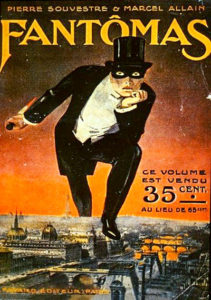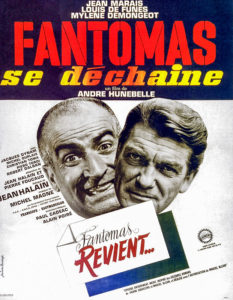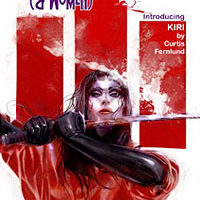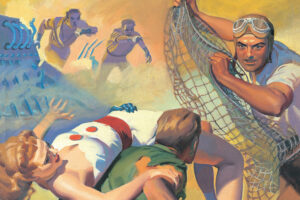 “Fantômas!”
“Fantômas!”“What did you say?”
“I said: Fantômas”
“And what does that mean?”
“Nothing…Everything!”
“But what is it?”
“No one…and yet, yes, it is someone!”
“And what does this someone do?”
“Spreads terror!“
Fantômas, Lord of Terror, Genius of Evil, is probably one of the most important villains in popular literature, more so that he carried his own series. When we think of villains who also starred in their own series, we think of Fu Manchu, maybe some of the very short-lived villain pulps, whereas Fantômas appeared before them and in many ways has had a wider influence.
Fantômas appeared in France in 1911, created by Marcel Allain and Pierre Souvestre. The two of them pumped out a total of 32 volumes over three years, then Allain would later write a subsequent set of 11 volumes alone after Souvestre’s death in 1914. They put out a new novel each month in a process that had them hash out the plot the first week, then each went off and wrote alternate chapters separately the second week. In the third week they met back up and checked out each other’s work and stitched the chapters together and gave instructions to the cover artists, then sent off the finished work in the fourth week.
Fantômas was inspired by previous villains such as Rocambole (before he went good), gentleman thieves like Arsene Lupin, and perhaps a bit of Zigomar, a crimelord who had his own series of pulp works in France just prior (1909 and later). Like these other characters, Fantômas was a master of disguise and stole, but unlike characters like Lupin, he had no problems with killing. He seemed to almost delight in it. He could be considered a “terrorist,” except he wasn’t motivated by politics or religion. He seemed more akin to the later “weird menace” villains or the foes that went up against The Spider. Like a phantom, he actually rarely appeared as Fantômas, instead usually appearing in disguises that only later were revealed as being him.
He was opposed by police inspector Juve (inspired by Monsieur Lecoq?), who was later revealed to be Fantômas’s twin! Juve was also a master of disguise to the point that his superiors sometimes thought that he might be Fantômas. Juve was aided by journalist Jerôme Fandor (inspired by Roulatabille?), whose father was murdered by Fantômas, who took his identity, then tried to frame him for another murder in the first novel. But Fandor may actually be a son of Fantômas! And then Fandor fell in love with Hélène, the daughter of Fantômas, and despite Fantômas’ best efforts to stop it, married her. And if you think that’s twisted, I haven’t gotten into Fantômas’ other son and lovers such as Lady Beltham, whose husband was killed by Fantômas.
The original series of novels consist of the following. I given the various titles to help those find them, but not all have been translated into English:
- Fantômas (1911; Brentano’s, 1915; Ballantine, 1986; Dover; Penguin)
- Juve vs. Fantômas/The Exploits of Juve/The Silent Executioner (1911; Brentano’s, 1916; Ballantine, 1987; Antipodes)
- The Dead Man Who Kills/The Vengeance of Fantômas/Messengers of Evil (1911; Brentano’s, 1917; Antipodes; Solar Books)
- The Secret Agent/A Ruse of Fantômas/A Nest of Spies (1911; Brentano’s, 1917)
- A King Prisoner of Fantômas/A Royal Prisoner (1911; Brentano’s, 1919; Antipodes)
- The Apache Policeman/Fantômas Policeman/The Long Arm of Fantômas (1911; Macaulay Co, 1924)
- The Hanged Man of London/In The Hands of Fantômas/Slippery as Sin (1911; Stanley, Paul & Co, 1920)
- The Daughter of Fantômas (1911; Black Coat Press)
- The Night Hansom Cab/The Hansom Cab of Fantômas (1911)
- The Severed Hand/Fantômas In Monaco/The Limb of Satan (1911; Macaulay Co, 1924)
- The Capture of Fantômas (1911)
- The Burglar Judge/Judge Fantômas (1912)
- The Livery of Crime/The Livery of Fantômas (1912)
- The Death of Juve/Fantômas Kills Juve (1912)
- The Escapee From Saint-Lazare/Fantômas, King of Crime (1912)
- The Disappearance of Fandor/Fandor vs. Fantômas (1912)
- The Wedding of Fantômas (1912)
- The Assassin of Lady Beltham/The Loves of Fantômas (1912)
- The Red Wasp/The Challenge of Fantômas (1912)
- The Dead Man’s Shoes/Fantômas Prowls (1912)
- The Lost Train/The Train of Fantômas (1912)
- The Love of A Prince/Fantômas Has Fun (1912)
- The Tragic Bouquet/The Bouquet of Fantômas (1912)
- The Masked Jockey/Fantômas, King of The Turf (1913)
- The Empty Coffin/The Coffin of Fantômas (1913)
- The Queen Maker/Fantômas vs. Love (1913)
- The Giant Corpse/The Spectre of Fantômas (1913)
- The Gold Thief/Prisoners of Fantômas! (1913)
- The Red Series/Fantômas Escapes (1913)
- Crime Hotel/Fantômas Accuses! (1913)
- The Hemp Necktie/The Servant of Fantômas (1913; Black Coat Press)
- The End of Fantômas/Is Fantômas Dead? (1913; Black Coat Press)
Successors
As noted, many pulp supervillains followed in Fantômas’ steps. How much is unclear, but as several of his stories were translated, he may have influenced villains like Fu Manchu and others.
Probably the clearest successors are the several comic book villains that appeared in Italian comics like Diabolik, Killing, Satanik, and others. The recent comic series, Nemesis, by Mark Millar, seems to me to be influenced by Fantômas, but I’ve seen nothing that indicates that.
Movies/TV
 Fantômas appeared in movies and TV, and doing so had a further impact. Like Zigomar, he appeared in several silent movie serials, a series of five from writer/director Louis Feuillade in 1913-14. He followed this with the Les Vampires serial, about a gang of criminals, and after the negative reaction to all this serials about villains, teamed up with the creator of Belphegor to create Judex (both of whom I have posted about previously). So one could thank Fantômas for leading to these other villains and a hero!
Fantômas appeared in movies and TV, and doing so had a further impact. Like Zigomar, he appeared in several silent movie serials, a series of five from writer/director Louis Feuillade in 1913-14. He followed this with the Les Vampires serial, about a gang of criminals, and after the negative reaction to all this serials about villains, teamed up with the creator of Belphegor to create Judex (both of whom I have posted about previously). So one could thank Fantômas for leading to these other villains and a hero!
There were several other Fantômas movies and a TV mini-series. But an interesting movie series appeared in the 1960s as a reaction to the James Bond series. Fantômas got three films from 1964 to ’66: Fantomas, Fantomas Strikes Back, and Fantomas vs. Scotland Yard. In these films, the same actor played Fantômas (who wore a pale blue face mask unless disguised as someone else) and journalist Fandor, while Juve was played for laughs by Louis de Funès. (So much for Fantômas & Juve being twins!) As far as I know, these films were never translated or dubbed into English. While not totally true to the original, the movies look like fun. See YouTube for clips, including the trailers.
Comics
There were several comic adaptions of Fantômas. What I think is more interesting is that he was adapted in Mexico, which at first followed the original novels, they then changed him into a character more like gentleman thief Arsene Lupin, though dressed in a colorful outfit. Kind of strange.
Today
Other then appearances in the Tales of the Shadowmen series at Black Coat Press, no one has made much use of Fantômas in modern times, which I think it too bad. While a very sinister character, I think in the right hands he can be interesting to use.
Until then, check out the several translations that are available. Also check out the excellent Fantomas Lives website for more info on the character, series, and tie-ins.




The silent movie serials I watched on Netflix last summer and they were pretty good. I dunno if they’re still available but if they are, they’re well worth checking out.
They are still available from Kino Video in a set, either DVD or BluRay. See Amazon.
Sadly, the 3 Fantomas movies from the 60s aren’t available in either English dub or subtitles.
Ah, thanks for the info! I would indeed like to have those serials on Blu-Ray. The influence of the French on pulp is a never ending source of fascination to me. Its as if pulp has always had a extensive and thirsty audience for the stuff that never lost their taste for it
I would also like to add, that the 1964 – 1966 movie trilogy with Louis de Funès and Jean Marais was released in most of the Eastern Block countries, becoming an instant hit (Over 60 million people watched it in the Soviet countries, compared to 4,5 million in it’s native France), and remains a cult-classic to this day, with numerous TV re-runs.
Also, are You sure those movies weren’t translated or dubbed into English? IMDB mentions US and UK premieres…
Can’t find any official English dub/subtitled version. No indication of such on Wikipedia or on Amazon.